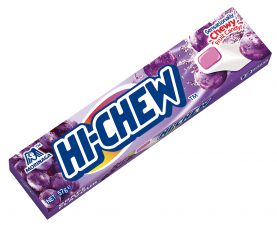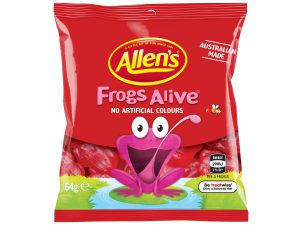For many of us, there are few things sweeter than a sugary treat. Sugar confectionery is the ultimate mood-lifter, an easy and quick pick-me-up and a way to share joy with family and friends. Whether it’s a single-serve treat picked up when refuelling or a share bag of lollies for those at home, confectionery is the indulgence of choice for many Australians.
According to the Australasian Association of Convenience Stores’ (AACS) State of the Industry Report for 2019, the confectionery market saw sales of $493 million last year, up 2.1% on 2018. It is the strongest result from the category since 2016.
The report also found that in the last five years, only 2017 failed to deliver growth, while the past two years have both seen $10 million in value growth. Sugar confectionery is the strongest performer in the category, accounting for 60% of the growth.
Our obsession peaks in October with the onset of Halloween. Last year confectionery company Mars Wrigley estimated Australians would shell out an incredible $159 million on the holiday period alone. And while the average spend was calculated at a modest $21, some families in Sydney’s affluent north shore area admitted to shelling out $1000 on confectionery for last year’s holiday.
AACS CEO Jeff Rogut said it remains an important category for convenience throughout the year.
“Confectionery remains a highly impulsive category in convenience stores and even in tough retail conditions, performs well as consumers seek out small treats for themselves,” Mr Rogut said.
A breakdown of results showed chocolate confectionery accounted for 57.3% of the category, sugar confectionery (including gum and mint) made up 38.9% and nutritional bars totalled 3.8%.
“Although chocolate bars are the core sellers in the category, sugar confectionery represents a solid percentage of sales. Promotions and innovative products drive sales in the category, as does store placement where products are within arms-reach of the service area,” Mr Rogut added.
Sugar confectionery performs well in grocery, too. According to IRI Australia, it’s worth approximately $570 million annually to the sector.
IRI also found that recent panic-buying sparked by COVID-19 had a positive affect on the category, with the value growth for the category in March this year– when panic buying began, at 11.6% compared to March 2019. However, the government imposed social distancing restrictions had a negative impact on petrol and convenience sales for that month. The drop in fuel demand and fewer public transport commuters had a drastic effect on sales, which IRI calculated at alarming 53% decline.
The global pandemic and resulting lifestyle changes, such as working from home and temporary pause on socialising also saw a change in the type of confectionery sought by consumers.
Earlier this year consumers sought permissible indulgence and premium products and value growth outpaced unit growth at 5.3% and 2.8% respectively as consumers traded up to fewer, more premium offerings, IRI said. However, once the pandemic hit, figures from March reveal unit growths outpaced value growth, at 18.8% and 11.6% respectively.
“Like most Food and Beverage categories Sugar Confectionery has benefited from the stockpiling and panic purchasing we have seen recently,” IRI Australia lead consultant Justin Nel said.
“However, I think there is also an element of allowed indulgence, as consumers take solace in comforting foods during these uncertain times. Not to mention all the parents and first-time teachers trying to manage their students.”

Australia’s high sugar confectionery consumption rate was a big drawcard for Morinaga, who recently introduced their popular Hi-Chew range of fruit flavoured, chewy lollies into the Australian market. The brand has a cult following and an incredible 170 flavours internationally. In Australia, they have introduced three 90g/100g packs of assorted flavours and four flavours in a stick format.
The brand appeals to Gen Z’s and millennials with a ‘discovery’ mindset, and as they sell at a higher retail price point to their competitors, also appeal to those with discerning tastes by being perceived as a more premium choice. The confectionery’s blend of familiar and exotic flavours also entices consumers to trail the chews.
Managing director and CEO of Morinaga Asia Pacific Terry Kawabe said the brand viewed Australia as one of the more favourable international markets.
“Consumption per capita in Australian of sugar confectionery is significantly higher than other Asian markets such as Japan and China,” Mr Kawabe said.
“The Australian trend is similar to the USA market where Morinaga have achieved great success over the 10 years. We believe the footprint in the USA should be synchronized in the Australian market.”
Mr Kawabe said the format of Hi-Chew was well suited to convenience, which was an important channel for the brand as impulse merchandising was key for driving sales.
“Grass root merchandising such as merchandising units at checkouts have worked extremely well in encouraging consumer trial. The different packs, sticks and bags are both ideal for the convenience channel. The stick is the ideal impulse and trial option,” he said.
“However, differentiation of the true to life fruit flavours, unique chewy texture, and flavour variety will definitely deliver exciting sales opportunity for convenience channels.”

One of the market leaders in Australian confectionery, Nestlé, are also experiencing growth. Their Allen’s range is the largest lolly brand in Australia and is worth $150 million.
Head of marketing confectionery at Nestlé, Joyce Tan, said the top sellers were Allen’s iconic lolly Snakes Alive, Party Mix, Retro Party Mix, Red Frogs, Chicos and Killer Pythons.
Of particular note were Snakes Alive (220g) which has grown 5.4%, Killer Pythons, up 21.8% and Frogs Alive, up 12.6%, according to the Nielsen Scantrack Combined Australia Grocery/Conv MAT (to 23/02/2020).
Interestingly, the top sellers in their medium lolly bags ranges remain the same across both convenience and grocery channels.
Fit for purpose products in convenience, such as Allen’s mini bags and travel cups, also continue to be strong performers for the brand and add incremental sales to the Allen’s range. Ms Tan said convenience stores were critical in driving impulse purchases and driving sales at counter and off-location displays was crucial to swaying consumers to try products, as they reached shoppers from multiple touchpoints.
Better-for-you treats have also been gaining in popularity in recent years. While they in no way replace indulgent treats, brands are looking to offer reduced sugar products and minimise or eliminate the use or artificial colours and flavours.
One brand which has been offering delicious fruit jelly lollies and chews free from artificial colours or flavours since 1991 is Mondelez’s The Natural Confectionery Co. The brand’s range of snakes, dinosaurs, sour squirms and fruity chews appeal to kids, while parents can take comfort in providing a treat with no-nasties. The brand has also delivered a reduced sugar option in their 25% less sugar range, which Euromonitor analyst Stevani Susanto said has been a hit with consumers.
Mr Susanto said sugar aversion was an increasing trend in confectionery, adding consumers’ health concerns were pushing them away from sugary snacks and towards those that are perceived as healthier or lower in sugar.
“In recent years, more sugar confectionery manufacturers have launched sugar-free or reduced-sugar variants of their products due to rising demand for low-sugar options as well as to reinvigorate sales,” Mr Susanto said.
“For example, under its The Natural Confectionery Co brand, Mondelez launched the 25% Less Sugar Jellies range in late 2018, while Nestlé followed suit by launching the 25% Less Sugar range under its Allen’s brand across supermarkets and independent grocery retailers in 2019.”
Another trend is the rise of sharing formats, as the consumption habits of consumers change and as consumers tend to feel less guilt about indulging when it was a shared experience, Mr Susanto said. This has been particularly true of chocolate.
“As chocolate confectionery posted relatively conservative growth, retailers were looking for ways to boost value sales through aligning their packaging with people’s consumption habits. As consumers seek out permissible indulgences, chocolate confectionery manufacturers were making it easier for consumers to indulge with less guilt,” he said.
“One of the ways this is done is by introducing larger packs for sharing occasions. For example, Robern Menz reintroduced a bag format of Violet Crumble in early 2019. When Violet Crumble was still under Nestlé, the bag format was stopped back in 2010. Robern Menz is bringing back this format in line with consumers’ increasing desire for portion control.”
AT A GLANCE:
- Value growth often outpaces unit growth in the category
- The impulsive nature of confectionery purchases makes it an important category for convenience
- Promotions and innovative products drive sales in the category, as does point of sale merchandising
- It is also a strong performer in grocery, where IRI Australia estimate its worth to the sector at $570 million
- Lower sugar options continue to grow in popularity as consumers become more health conscious

